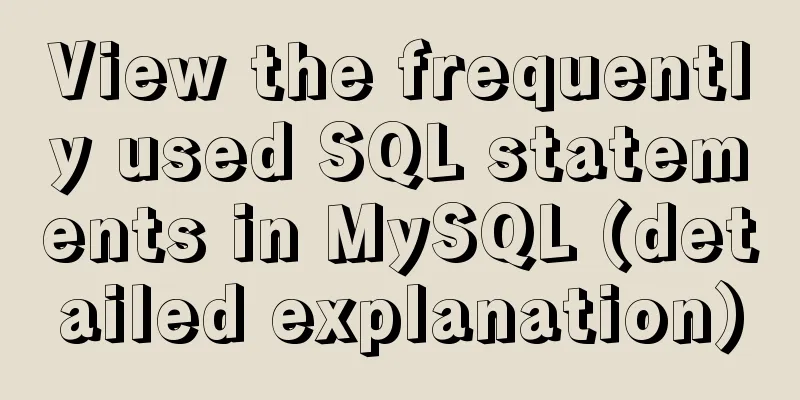Teach you how to build hive3.1.2 on Tencent Cloud

|
Environment Preparation Before starting any operation, make sure that the hadoop version has been installed. For details, please refer to my other blog post on building hadoop3.x mysql installation First put the installation package in the software folder and unzip it into mysql-lib [root@master software]# ll Total usage 1422372 -rw-r--r-- 1 root root 312850286 July 2 15:00 apache-hive-3.1.2-bin.tar.gz -rw-r--r-- 1 root root 338075860 Jul 2 09:39 hadoop-3.1.3.tar.gz -rw-r--r-- 1 root root 195013152 July 2 09:36 jdk-8u212-linux-x64.tar.gz -rw-r--r-- 1 root root 609556480 Jul 2 15:08 mysql-5.7.28-1.el7.x86_64.rpm-bundle.tar -rw-r--r-- 1 root root 985600 Jul 2 14:44 mysql-connector-java-5.1.37.jar [root@master software]# mkdir mysql-lib [root@master software]# tar -xf mysql-5.7.28-1.el7.x86_64.rpm-bundle.tar -C ./mysql-lib/ [root@master software]# cd mysql-lib/ [root@master mysql-lib]# ll Total usage 595272 -rw-r--r-- 1 7155 31415 45109364 Sep 30 2019 mysql-community-client-5.7.28-1.el7.x86_64.rpm -rw-r--r-- 1 7155 31415 318768 September 30, 2019 mysql-community-common-5.7.28-1.el7.x86_64.rpm -rw-r--r-- 1 7155 31415 7037096 Sep 30 2019 mysql-community-devel-5.7.28-1.el7.x86_64.rpm -rw-r--r-- 1 7155 31415 49329100 Sep 30 2019 mysql-community-embedded-5.7.28-1.el7.x86_64.rpm -rw-r--r-- 1 7155 31415 23354908 September 30, 2019 mysql-community-embedded-compat-5.7.28-1.el7.x86_64.rpm -rw-r--r-- 1 7155 31415 136837816 Sep 30 2019 mysql-community-embedded-devel-5.7.28-1.el7.x86_64.rpm -rw-r--r-- 1 7155 31415 4374364 Sep 30 2019 mysql-community-libs-5.7.28-1.el7.x86_64.rpm -rw-r--r-- 1 7155 31415 1353312 Sep 30 2019 mysql-community-libs-compat-5.7.28-1.el7.x86_64.rpm -rw-r--r-- 1 7155 31415 208694824 September 30, 2019 mysql-community-server-5.7.28-1.el7.x86_64.rpm -rw-r--r-- 1 7155 31415 133129992 September 30, 2019 mysql-community-test-5.7.28-1.el7.x86_64.rpm Deal with the environment first, because centos comes with mariadb, which will cause conflicts, so you need to uninstall it first [root@master mysql-lib]# rpm -qa|grep mariadb mariadb-libs-5.5.56-2.el7.x86_64 [root@master mysql-lib]# sudo rpm -e --nodeps mariadb-libs # Check if the uninstall is complete [root@master mysql-lib]# rpm -qa|grep mariadb [root@master mysql-lib]# rpm -qa|grep mysql There is no problem, you can install it. Be sure to install it in order. [root@master mysql-lib]# ll Total usage 595284 -rw-r--r-- 1 7155 31415 45109364 Sep 30 2019 mysql-community-client-5.7.28-1.el7.x86_64.rpm -rw-r--r-- 1 7155 31415 318768 September 30, 2019 mysql-community-common-5.7.28-1.el7.x86_64.rpm -rw-r--r-- 1 7155 31415 7037096 Sep 30 2019 mysql-community-devel-5.7.28-1.el7.x86_64.rpm -rw-r--r-- 1 7155 31415 49329100 Sep 30 2019 mysql-community-embedded-5.7.28-1.el7.x86_64.rpm -rw-r--r-- 1 7155 31415 23354908 September 30, 2019 mysql-community-embedded-compat-5.7.28-1.el7.x86_64.rpm -rw-r--r-- 1 7155 31415 136837816 Sep 30 2019 mysql-community-embedded-devel-5.7.28-1.el7.x86_64.rpm -rw-r--r-- 1 7155 31415 4374364 Sep 30 2019 mysql-community-libs-5.7.28-1.el7.x86_64.rpm -rw-r--r-- 1 7155 31415 1353312 Sep 30 2019 mysql-community-libs-compat-5.7.28-1.el7.x86_64.rpm -rw-r--r-- 1 7155 31415 208694824 September 30, 2019 mysql-community-server-5.7.28-1.el7.x86_64.rpm -rw-r--r-- 1 7155 31415 133129992 September 30, 2019 mysql-community-test-5.7.28-1.el7.x86_64.rpm [root@master mysql-lib]# sudo rpm -ivh mysql-community-common-5.7.28-1.el7.x86_64.rpm Warning:mysql-community-common-5.7.28-1.el7.x86_64.rpm: Header V3 DSA/SHA1 Signature, Key ID 5072e1f5: NOKEY Preparing... ################################# [100%] Upgrading/installing... 1:mysql-community-common-5.7.28-1.e################################### [100%] [root@master mysql-lib]# sudo rpm -ivh mysql-community-libs-5.7.28-1.el7.x86_64.rpm Warning:mysql-community-libs-5.7.28-1.el7.x86_64.rpm: Header V3 DSA/SHA1 Signature, Key ID 5072e1f5: NOKEY Preparing... ################################# [100%] Upgrading/installing... 1:mysql-community-libs-5.7.28-1.el7################################### [100%] [root@master mysql-lib]# sudo rpm -ivh mysql-community-libs-compat-5.7.28-1.el7.x86_64.rpm Warning:mysql-community-libs-compat-5.7.28-1.el7.x86_64.rpm: Header V3 DSA/SHA1 Signature, Key ID 5072e1f5: NOKEY Preparing... ################################# [100%] Upgrading/installing... 1:mysql-community-libs-compat-5.7.2################################### [100%] [root@master mysql-lib]# sudo rpm -ivh mysql-community-client-5.7.28-1.el7.x86_64.rpm Warning:mysql-community-client-5.7.28-1.el7.x86_64.rpm: Header V3 DSA/SHA1 Signature, Key ID 5072e1f5: NOKEY Preparing... ################################# [100%] Upgrading/installing... 1:mysql-community-client-5.7.28-1.e################################### [100%] When installing the 5th one, if centos is installed minimally, this problem will be reported
[root@master mysql-lib]# sudo rpm -ivh mysql-community-server-5.7.28-1.el7.x86_64.rpm
Warning:mysql-community-server-5.7.28-1.el7.x86_64.rpm: Header V3 DSA/SHA1 Signature, Key ID 5072e1f5: NOKEY
ERROR: Dependency check failed:
libnuma.so.1()(64bit) is needed by mysql-community-server-5.7.28-1.el7.x86_64 libnuma.so.1(libnuma_1.1)(64bit) is needed by mysql-community-server-5.7.28-1.el7.x86_64 libnuma.so.1(libnuma_1.2)(64bit) is needed by mysql-community-server-5.7.28-1.el7.x86_64[root@master mysql-lib]# yum install -y libaio [root@master mysql-lib]# yum install -y numactl Then try to install it again and it will be fine [root@master mysql-lib]# sudo rpm -ivh mysql-community-server-5.7.28-1.el7.x86_64.rpm Warning:mysql-community-server-5.7.28-1.el7.x86_64.rpm: Header V3 DSA/SHA1 Signature, Key ID 5072e1f5: NOKEY Preparing... ################################# [100%] Upgrading/installing... 1:mysql-community-server-5.7.28-1.e################################### [100%] Clean up historical residual files [root@master mysql-lib]# cat /etc/my.cnf # For advice on how to change settings please see # http://dev.mysql.com/doc/refman/5.7/en/server-configuration-defaults.html [mysqld] # # Remove leading # and set to the amount of RAM for the most important data # cache in MySQL. Start at 70% of total RAM for dedicated server, else 10%. # innodb_buffer_pool_size = 128M # # Remove leading # to turn on a very important data integrity option: logging # changes to the binary log between backups. # log_bin # # Remove leading # to set options mainly useful for reporting servers. # The server defaults are faster for transactions and fast SELECTs. # Adjust sizes as needed, experiment to find the optimal values. # join_buffer_size = 128M # sort_buffer_size = 2M # read_rnd_buffer_size = 2M datadir=/var/lib/mysql socket=/var/lib/mysql/mysql.sock # Disabling symbolic-links is recommended to prevent assorted security risks symbolic-links=0 log-error=/var/log/mysqld.log pid-file=/var/run/mysqld/mysqld.pid I saw that the mysql directory is #Enter this address to see if there are any historical residual files [root@master mysql-lib]# cd /var/lib/mysql # If there is nothing, then it is fine. If there is something, just delete it. [root@master mysql]# ll Total usage 0 Initialize mysql [root@master mysql]# sudo mysqld --initialize --user=mysql Check the default password [root@master mysql]# cat /var/log/mysqld.log 2020-07-02T07:29:10.095244Z 0 [Warning] TIMESTAMP with implicit DEFAULT value is deprecated. Please use --explicit_defaults_for_timestamp server option (see documentation for more details). 2020-07-02T07:29:11.331738Z 0 [Warning] InnoDB: New log files created, LSN=45790 2020-07-02T07:29:11.498492Z 0 [Warning] InnoDB: Creating foreign key constraint system tables. 2020-07-02T07:29:11.590436Z 0 [Warning] No existing UUID has been found, so we assume that this is the first time that this server has been started. Generating a new UUID: b94654a6-bc35-11ea-a160-525400f3e388. 2020-07-02T07:29:11.600554Z 0 [Warning] Gtid table is not ready to be used. Table 'mysql.gtid_executed' cannot be opened. 2020-07-02T07:29:13.093996Z 0 [Warning] CA certificate ca.pem is self signed. 2020-07-02T07:29:13.522160Z 1 [Note] A temporary password is generated for root@localhost: p;oK<M)<_8p/ The password is Enter mysql Start mysql service
[root@master mysql]# systemctl start mysqld
[root@master mysql]# systemctl status mysqld
● mysqld.service – MySQL Server
Loaded: loaded (/usr/lib/systemd/system/mysqld.service; enabled; vendor preset: disabled)
Active: active (running) since Thursday 2020-07-02 15:31:00 CST; 10s ago
Docs: man:mysqld(8)
http://dev.mysql.com/doc/refman/en/using-systemd.html
Process: 5617 ExecStart=/usr/sbin/mysqld --daemonize --pid-file=/var/run/mysqld/mysqld.pid $MYSQLD_OPTS (code=exited, status=0/SUCCESS)
Process: 5497 ExecStartPre=/usr/bin/mysqld_pre_systemd (code=exited, status=0/SUCCESS)
Main PID: 5624 (mysqld)
Tasks: 27
Memory: 205.4M
CGroup: /system.slice/mysqld.service
└─5624 /usr/sbin/mysqld --daemonize --pid-file=/var/run/mysqld/mysqld.pid...
Jul 02 15:30:55 master systemd[1]: Starting MySQL Server...
Jul 02 15:31:00 master systemd[1]: Started MySQL Server.Enter mysql $ mysql -u root -p When prompted to enter a password, enter the password you just copied.
After successfully entering mysql, set our mysql password, remember this yourself~
#Set the password to your passwordmysql> set password = password("your password");
Next, set the root user's permissions to allow any IP connection to prepare for the subsequent hive connection mysql> use mysql; mysql> select host,user from user; +-----------+---------------+ | host | user | +-----------+---------------+ | localhost | mysql.session | | localhost | mysql.sys | | localhost | root | +-----------+---------------+ 3 rows in set (0.00 sec) mysql> update mysql.user set host='%' where user='root'; Query OK, 1 row affected (0.00 sec) Rows matched: 1 Changed: 1 Warnings: 0 # The ones with higher permissions are at the top (optimized in the new version) mysql> select host,user from user; +-----------+---------------+ | host | user | +-----------+---------------+ | % | root | | localhost | mysql.session | | localhost | mysql.sys | +-----------+---------------+ 3 rows in set (0.00 sec) --This step must be done to refresh the configuration, otherwise the password will not take effectmysql> flush privileges; Query OK, 0 rows affected (0.00 sec) mysql> quit Then try to log in with the changed password. If successful, the configuration is complete. Install Hive Go to the /home/centos/software directory and unzip apache-hive-3.1.2-bin.tar.gz to the /home/centos/module/ directory [root@master software]# tar -zxvf apache-hive-3.1.2-bin.tar.gz -C /home/centos/module/ Enter the module folder and change the file name [root@master module]# ll Total dosage 12 drwxr-xr-x 9 root root 4096 July 2 15:40 apache-hive-3.1.2-bin drwxr-xr-x 11 centos centos 4096 July 2 11:51 hadoop-3.1.3 drwxr-xr-x 7 10 143 4096 April 2 2019 jdk1.8.0_212 [root@master module]# mv apache-hive-3.1.2-bin/ hive [root@master module]# ll Total dosage 12 drwxr-xr-x 11 centos centos 4096 July 2 11:51 hadoop-3.1.3 drwxr-xr-x 9 root root 4096 July 2 15:40 hive drwxr-xr-x 7 10 143 4096 April 2 2019 jdk1.8.0_212 Configuring environment variables [root@master module]# vim /etc/profile.d/my_env.sh #HIVE_HOME export HIVE_HOME=/home/centos/module/hive export PATH=$PATH:$HIVE_HOME/bin Load the environment variables and verify whether they are successful [root@master module]# source /etc/profile [root@master module]# echo $HIVE_HOME /home/centos/module/hive Resolving log Jar package conflicts There is a log4j version conflict between hadoop and hive. You need to change the name of the jar package in the hive lib folder so that it cannot be enabled. Just add .bak to the end of the file name. [atguigu@hadoop102 lib]$ mv log4j-slf4j-impl-2.10.0.jar log4j-slf4j-impl-2.10.0.jar.bak [atguigu@hadoop102 lib]$ ll | grep log4j -rw-rw-r--. 1 atguigu atguigu 63835 Apr 15 00:34 log4j-1.2-api-2.10.0.jar -rw-rw-r--. 1 atguigu atguigu 255485 Apr 15 00:24 log4j-api-2.10.0.jar -rw-rw-r--. 1 atguigu atguigu 1597622 Apr 15 00:24 log4j-core-2.10.0.jar -rw-rw-r--. 1 atguigu atguigu 24173 Apr 15 00:24 log4j-slf4j-impl-2.10.0.jar.bak -rw-rw-r--. 1 atguigu atguigu 32060 Apr 15 00:34 log4j-web-2.10.0.jar Hive metadata configuration to MySQL Copy the MySQL JDBC driver to the Hive lib directory [root@master lib]# cp /home/centos/software/mysql-connector-java-5.1.37.jar ./ Check if the copy is successful [root@master lib]# ll | grep mysql-con -rw-r--r-- 1 root root 985600 Jul 2 15:47 mysql-connector-java-5.1.37.jar Configure metastore to mysql Create a new hive-site.xml file in the $HIVE_HOME/conf directory. [root@master conf]# vim hive-site.xml There are three values you need to change.
<?xml version="1.0"?>
<?xml-stylesheet type="text/xsl" href="configuration.xsl" rel="external nofollow" ?>
<configuration>
<!-- URL for jdbc connection -->
<property>
<name>javax.jdo.option.ConnectionURL</name>
<value>jdbc:mysql://Tencent Cloud intranet ip:3306/metastore?useSSL=false</value>
</property>
<!-- JDBC connection Driver -->
<property>
<name>javax.jdo.option.ConnectionDriverName</name>
<value>com.mysql.jdbc.Driver</value>
</property>
<!-- jdbc connection username -->
<property>
<name>javax.jdo.option.ConnectionUserName</name>
<value>root</value>
</property>
<!-- Password for jdbc connection -->
<property>
<name>javax.jdo.option.ConnectionPassword</name>
<value>Your mysql password</value>
</property>
<!-- Hive's default working directory in HDFS -->
<property>
<name>hive.metastore.warehouse.dir</name>
<value>/user/hive/warehouse</value>
</property>
<!-- Verification of Hive metadata storage version -->
<property>
<name>hive.metastore.schema.verification</name>
<value>false</value>
</property>
<!-- Specify the address to connect to for storing metadata -->
<property>
<name>hive.metastore.uris</name>
<value>thrift://Tencent Cloud intranet ip:9083</value>
</property>
<!-- Specify the port number for hiveserver2 connection-->
<property>
<name>hive.server2.thrift.port</name>
<value>10000</value>
</property>
<!-- Specify the host to which hiveserver2 connects -->
<property>
<name>hive.server2.thrift.bind.host</name>
<value>Your local hostname</value>
</property>
<!-- Metadata storage authorization -->
<property>
<name>hive.metastore.event.db.notification.api.auth</name>
<value>false</value>
</property>
<!-- High availability parameters of hiveserver2. Enabling this parameter can improve the startup speed of hiveserver2. -->
<property>
<name>hive.server2.active.passive.ha.enable</name>
<value>true</value>
</property>
</configuration>After pasting the modified content, save and exit Start hive Initialize the metadata database Log in to MySQL and create a hive metabase mysql> create database metastore; Query OK, 1 row affected (0.00 sec) Exit and initialize the hive metabase # Let hive create the initialized table in metastore [atguigu@hadoop102 software]$ schematool -initSchema -dbType mysql -verbos Enter mysql again and check that it has been created (74 tables) mysql> use metastore; mysql> show tables; Create a startup script, otherwise it would be too annoying to write such a long script every time to start it in the background. [root@master bin]# vim hs.sh Add the following content
#!/bin/bash
HIVE_LOG_DIR=$HIVE_HOME/logs
#Judge whether this directory exists, if not, create it if [ ! -d $HIVE_LOG_DIR ]
then
mkdir -p $HIVE_LOG_DIR
fi
#Check whether the process is running normally, parameter 1 is the process name, parameter 2 is the process port #status
function check_process()
{
#/dev/null Black hole unwanted streams are placed here for destruction pid=$(ps -ef 2>/dev/null | grep -v grep | grep -i $1 | awk '{print $2}')
ppid=$(netstat -nltp 2>/dev/null | grep $2 | awk '{print $7}' | cut -d '/' -f 1)
echo $pid
[[ "$pid" =~ "$ppid" ]] && [ "$ppid" ] && return 0 || return 1
}
#start
function hive_start()
{
metapid=$(check_process HiveMetastore 9083)
#Just understand this line, this line is to start the service background cmd="nohup hive --service metastore >$HIVE_LOG_DIR/metastore.log 2>&1 &"
cmd=$cmd" sleep 4; hdfs dfsadmin -safemode wait >/dev/null 2>&1"
[ -z "$metapid" ] && eval $cmd || echo "Metastroe service has been started"
server2pid=$(check_process HiveServer2 10000)
#Just understand this line, this line is to start the service background cmd="nohup hive --service hiveserver2 >$HIVE_LOG_DIR/hiveServer2.log 2>&1 &"
[ -z "$server2pid" ] && eval $cmd || echo "HiveServer2 service has started"
}
#stop
function hive_stop()
{
metapid=$(check_process HiveMetastore 9083)
[ "$metapid" ] && kill $metapid || echo "Metastore service is not started"
server2pid=$(check_process HiveServer2 10000)
[ "$server2pid" ] && kill $server2pid || echo "HiveServer2 service is not started"
}
case $1 in
"start")
hive_start
;;
"stop")
hive_stop
;;
"restart")
hive_stop
sleep 2
hive_start
;;
"status")
check_process HiveMetastore 9083 >/dev/null && echo "Metastore service is running normally" || echo "Metastore service is running abnormally"
check_process HiveServer2 10000 >/dev/null && echo "HiveServer2 service is running normally" || echo "HiveServer2 service is running abnormally"
;;
*)
echo Invalid Args!
echo 'Usage: '$(basename $0)' start|stop|restart|status'
;;
esacSave and exit, add permissions to the script $ chmod +x hs.sh Now let's start it (make sure that Hadoop is started and running normally before starting) [root@master bin]# hs.sh start [root@master bin]# jps 32177 SecondaryNameNode 514 NodeManager 20788 Jps 31396 NameNode 32652 ResourceManager 20253 RunJar 31757 DataNode 991 JobHistoryServer You can see that the startup is successful. Let's use the script to see the status [root@master bin]# hs.sh status The Metastore service is running abnormally. The HiveServer2 service is running abnormally. You may be surprised to find that there is an abnormal operation. What is going on? Actually, it is because it starts slowly. If you don’t believe me, try again after two minutes. [root@master bin]# hs.sh status The Metastore service is running normally. The HiveServer2 service is running normally. hive jdbc access beeline If you did not use root to build hadoop, then change it according to your own settings. #You must use root access because the jdbc administrator is root, otherwise you have no permission -n is followed by the user to log in [atguigu@hadoop102 bin]$ beeline -u jdbc:hive2://master:10000 -n root Connecting to jdbc:hive2://master:10000 Connected to: Apache Hive (version 3.1.2) Driver: Hive JDBC (version 3.1.2) Transaction isolation: TRANSACTION_REPEATABLE_READ Beeline version 3.1.2 by Apache Hive 0: jdbc:hive2://master:10000> This means you have successfully entered. If you exit 0: jdbc:hive2://master:10000> !quit Closing: 0: jdbc:hive2://master:10000 hive command line [atguigu@hadoop102 bin]$ hive #A bunch of information hive> This means you have successfully entered. To exit, just History Their history records are in the home directory $ cd ~ $ ls -a You can see a Hive operation log configuration By default, Hive logs are stored under the current user name. We also put Hive's own operation logs in this logs for easy viewing later. (1) Modify the file name of $ mv hive-log4j2.properties.template hive-log4j.properties $ vim hive-log4j.properties (2) Modify the log storage location in the hive-log4j.properties file property.hive.log.dir=/home/centos/module/hive/logs
Hive startup jvm heap memory settings When the new version of Hive is started, the default jvm heap memory size requested is 256M. The jvm heap memory requested is too small, which leads to the error [atguigu@hadoop102 conf]$ cp hive-env.sh.template hive-env.sh [atguigu@hadoop102 conf]$ vim hive-env.sh Uncomment the parameter
After completing all the above configurations, restart hive. Connecting hive from windows I recommend dbeaver. Remember to go to the security group and open port 10000 before connecting.
The specific configuration steps are as follows
Then
Test the connection and wait for about 1 minute. It will basically be successful. Then you can have fun with hive on Windows. This is the end of this article about how to build hive3.1.2 on Tencent Cloud. For more information about building hive3.1.2 on Tencent Cloud, please search for previous articles on 123WORDPRESS.COM or continue to browse the following related articles. I hope you will support 123WORDPRESS.COM in the future! You may also be interested in:
|
<<: Summary of various methods for JS data type detection
>>: Detailed process of building mysql5.7.29 on centos7 of linux
Recommend
Detailed explanation of Linux DMA interface knowledge points
1. Two types of DMA mapping 1.1. Consistent DMA m...
CSS achieves the effect of changing the color of the entire line when the mouse is placed on it
summary: The following is a method for changing t...
MySQL aggregate function sorting
Table of contents MySQL result sorting - Aggregat...
Angular framework detailed explanation of view abstract definition
Preface As a front-end framework designed "f...
Sample code for displaying reminder dots in the upper left or upper right corner using CSS3
Effect picture (if you want a triangle, please cl...
JavaScript to achieve simple drag effect
This article shares the specific code of JavaScri...
How to solve the problem that VMware virtual machine bridge mode cannot access the Internet
Step 1: Check the local Ethernet properties to se...
Vue implements the frame rate playback of the carousel
This article example shares the specific code of ...
How to clear the cache after using keep-alive in vue
What is keepalive? In normal development, some co...
10 very good CSS skills collection and sharing
Here, clever use of CSS techniques allows you to g...
Simple usage example of MySQL 8.0 recursive query
Preface This article uses the new features of MyS...
Ubuntu 15.04 opens mysql remote port 3306
Ubuntu 15.04 opens MySQL remote port 3306. All th...
How to implement nested if method in nginx
Nginx does not support nested if statements, nor ...
A brief introduction to web2.0 products and functions
<br />What is web2.0? Web2.0 includes those ...
How to enter directory/folder in Linux without using CD command
As we all know, without the cd command, we cannot...















